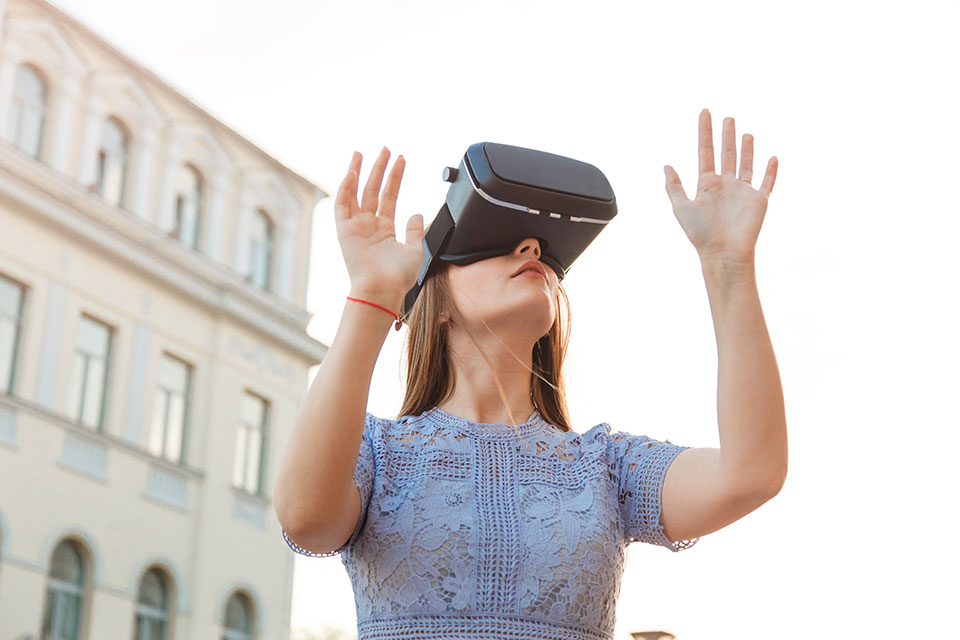A Glimpse Into the Future of AR and VR Brand Storytelling

Augmented and virtual reality are the future of meaningful, immersive customer experiences. By tapping into technology trends, you can better tell your brand’s story and resonate with audiences. The key is taking a holistic approach to engage every channel, sense, and possibility.
Over the past few years, there have been tremendous advancements in augmented and virtual reality. Branded social media filters, product visualization tools, and more have created new ways for consumers to interact with companies.
AR and VR have the potential to usher in a new era of brand storytelling. Whole Foods, for example, replicated the shopping experience online in the wake of COVID-19. Customers could browse digital locations, complete with dynamic prices and product selections. By capitalizing on VR’s potential, the grocery store chain created a safe and on-brand touchpoint for consumers displaced by the pandemic.
Moving forward, you can also seize the moment and create immersive experiences using these technologies. But one question remains: How can you better connect with your customers?
Advancements and Advantages of AR and VR
More and more organizations are adopting AR and VR technology. Beauty brands like Sephora allow consumers to try on makeup virtually, and e-commerce companies like Wayfair help customers see how different home goods look in their rooms. Even companies that lack tangible products are using VR: Topgolf launched a gaming experience for Facebook’s Oculus Quest.
Brands aren’t the only ones excited about AR and VR, though. According to a 2019 Nielsen survey, they were the top technologies consumers hoped to use to improve their lives, and 51% said they’d use AR and VR to check out products before buying. Shopify’s research supports these findings: Products with VR content had a 94% higher conversion rate.
To see similar results, you need to let people interact directly with your offering and brand. For instance, Inspira Marketing Group created a 4D driving experience for Jeep’s Winter X Games sponsorship. Consumers found themselves behind the wheel of a Jeep Wrangler as it crawled over boulders and sped across a desert landscape. Participants weren’t just watching the story unfold — they were a part of it. High-quality visuals paired with other effects to create a multisensory experience.
If you want to level up your brand storytelling using AR and VR, you need to make sure each implementation serves a purpose. Does it make consumers’ lives easier? Is it entertaining? How will people use it to connect with your brand? Once you determine what you’re trying to accomplish, you can use AR and VR technologies to make it happen.
Implementing AR and VR Brand Storytelling
Want to create a memorable, meaningful experience for your brand? Follow these three steps to use AR and VR successfully:
- Use every channel.
Think strategically about how your idea can come to life in an integrated campaign. Physical events, virtual events, social media shoutouts, influencer endorsements, and more all work together to amplify your reach. Let’s say you’re preparing to debut a new clothing line. You could create a custom AR filter for social media, use AR or VR product visualization on your website (like the ASOS Virtual Catwalk), add a unique in-store experience (like Nike’s custom sneaker AR fitting), or host a VR event where consumers can view a digital fashion show. - Dream big.
The pandemic is accelerating digital transformation in every industry, causing technologies to evolve practically overnight. In this kind of environment, it’s essential to realize that you might have to blaze some new trails. It might seem scary, but the only limitation of AR and VR is your imagination. With the right team or partners, you can make all of your ideas a reality. That’s why organizations like VF (the owner of brands like Timberland and Vans) opened a retail space in London dedicated to testing and learning new technology features. - Cater to all the senses.
More than 75% of event professionals agree that multisensory experiences involving tastes, sounds, and smells tend to be more memorable. In our Jeep experience mentioned above, four wind effect generators ensured that attendees felt a rush of air when the vehicle’s top was down, and two scent units released a custom blend that mimicked the aroma of a pine forest and desert landscape. Incorporating similar details can transform your audience from passive spectators into active participants.
The isolation of the pandemic has only amplified the importance of virtual experiences that feel as close as possible to real life. Under these lingering circumstances, the brands that master AR and VR first will have a serious leg up on their 2D competitors.
Written by Jeff Snyder. Have you read?
Most Startup Friendly Countries In The World.
The World’s Best Countries For Business For Non-European Investors.
Most Powerful Countries.
Most Influential Countries.
Bring the best of the CEOWORLD magazine's global journalism to audiences in the United States and around the world. - Add CEOWORLD magazine to your Google News feed.
Follow CEOWORLD magazine headlines on: Google News, LinkedIn, Twitter, and Facebook.
Copyright 2025 The CEOWORLD magazine. All rights reserved. This material (and any extract from it) must not be copied, redistributed or placed on any website, without CEOWORLD magazine' prior written consent. For media queries, please contact: info@ceoworld.biz









